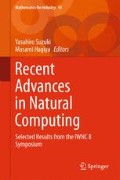Abstract
There are two kinds of consciousness which arise in the creative process of drawing. One is the consciousness that one is trying to draw a picture. The other is the consciousness that one is made to draw a picture while facing various material resistances. In this research, drawing experiments were conducted using a parallel link-type robot which played the role of medium, combining the two kinds of consciousness to show the subjectivity in dynamic flows of consciousness. The experimental system was as follows. Participant #1 draws a free line on a tablet computer. Participant #2 only holds the pen to a moving board on the robot. When the robot moves the drawing board under the pen, the line drawing is recreated on the board. The robot’s movements are inversely transformed by the participant’s. Results indicate that even if Participant #2 did not move their own hand, they recognize the picture drawn on the robot board as their own. Additionally, they could identify who drew the drawings on the tablet by using only haptic information from the robots movements.
Access this chapter
Tax calculation will be finalised at checkout
Purchases are for personal use only
References
Turing, A.M.: Computing machinery and intelligence. Mind 59, 433–460 (1950)
Hofstadter, D.R.: GNodel, Escher, Bach: an Eternal Golden Braid. Basic Books, New York (1979)
Libet, B., Wright Jr, E.W., Gleason, C.A.: Readiness-potentials preceding unrestricted espontaneous vs pre-planned voluntary acts. Electroencephalogr Clin Neurophysiol 54(3), 322–335 (1982)
Miyake, Y.: Interpersonal synchronization of body motion and the Walk-Mate walking support robot. IEEE Trans. Robot. 25(3), 638–644 (2009)
Miyake, Y.: Co-creation system and human-computer interaction. In: Sakai, T., Tanaka, K., Rose, K., Kita, H., Jozen, T., Takada, H. (eds.) 3-rd Conference on Creating, Connecting and Collaborating through Computing (C5 2005), pp. 169–172. IEEE Computer Society Press, Los Alamitos (2005)
Ikemoto, S., Minato, T., Ishiguro, H.: Analysis of physical human-robots interaction for motor learning with physical help. Appl. Bionics Biomechan. 5(4), 213–223 (2008)
HAYABUSA—A Technology Demonstrator for Sample and Return. Mission pamphlet, JAXA (2010)
Mars Science Laboratory/Curiosity. Fact sheet, NASA (2012)
McLuhan, H.M.: Understanding Media: the Extensions of Man. McGraw-Hill, New York (1964)
Merleau-Ponty, M.: PhLenomLenologie de la Perception. Gallimard, Paris (1945)
Botvinick, M., Cohen, J.: Rubber hands ‘feel’ touch that eyes see. Nature 391, 756 (1998)
Anani, A.B., Ikeda, K., Korner, L.M.: Human ability to discriminate various parameters in afferent electrical nerve stimulation with particular reference to prostheses sensory feedback. Med. Biol. Eng. Comput. 15, 363–373 (1977)
Ramachandran, V.S., Blakeslee, S.: Phantoms in the Brain: Probing the Mysteries of the Human Mind. William Morrow and Co., New York (1998)
Ehrsson, H.H., RosLen, B., Stockselius, A., RagnNo, C., KNohler, P., Lundborg, G.: Upper limb amputees can be induced to experience a rubber hand as their own. Brain 131(12), 3443–3452 (2008)
Marasco, P.D., Kim, K., Colgate, J.E., Peshkin, M.A., Kuiken, T.A.: Robotic touch shifts perception of embodiment to a prosthesis in targeted reinnervation amputees. Brain 134(3), 747–758 (2011)
Kudoh, S., Ogawara, K., Komachiya, K., Ikeuchi, K.: Painting simulation using robots. In: Gart and Robotsh workshop of IEEE/RSJ 2008 International Conference on Intelligent Robots and Systems, Nice, France (2008)
Aristotle: De Anima (On the soul). (350 BC), In: Nakahata, M., (Trans.) Kyoto University Press, Kyoto (2001)
de Vignemont, F., Fourneret, P.: The sense of agency: a philosophical and empirical review of the gWhoh system. Conscious. Cogn. 13, 1–19 (2004)
Kaptelinin, V., Nardi, B.A.: Acting with Technology: Activity Theory and Interaction Design. MIT Press, Cambridge (2006)
Aoyama, M.: Agency reexamined: how artifacts design human agency. Cogn. Stud. 19(2), 164–174 (2012). (in Japanese)
Okazaki, K.: Robots create humans: The definition of robot through art, or the definition of human and art through robot. In: Gart and Robotsh workshop of IEEE/RSJ 2008 International Conference on Intelligent Robots and Systems, Nice, France (2008)
Suchman, L.A.: Human-Machine Reconfigurations: Plans and Situated Actions, 2nd edn. Cambridge University Press, New York (2007)
Goan, M., Tsujita, K., Kihara, S., Okazaki, K.: The generation of emotional transmission via medium-perceiving drawing system and the plasticity of subjects. In: Suzuki, Y., Hagiya, M. (eds.) Recent Advances in Natural Computing, Mathematics for Industry, vol. 9, pp. 99–112 (2014)
Vlassova, A., Donkin, C., Pearson, J.: Unconscious information changes decision accuracy but not confidence. PNAS, Published online before print October 27, 2014. doi:10.1073/pnas.1403619111
Tresset, P., Leymarie, F.F.: Portrait drawing by Paul the robot. Comput. Graph. 37(5), 348–363 (2013)
Gibson, J.J.: The senses considered as perceptual systems. Houghton Mifflin, Boston (1966)
Iwamura, Y., Tanaka, M., Sakamoto, M., Hikosaka, O.: Vertical neuronal arrays in the postcentral gyrus signaling active touch: a receptive field study in the conscious monkey. Exp. Brain Res. 58(2), 412–420 (1985)
Turvey, M.T.: Dynamic touch. Am. Psychol. 51(11), 1134–1152 (1996)
Katz, D., Krueger, L.E. (Trans.): The World of Touch. Erlbaum, Hillsdale (1989)
Shibata, T.: David Katz—The Uniqueness of His Theory of Medium: A Comparative Study with J.J. Gibsonfs Theory of Tool. Bulletin of the Graduate School of Education, the University of Tokyo, vol. 43, pp. 279–286 (2003) (in Japanese)
Acknowledgments
This work was partially supported by a Grant-in-Aid for Scientific Research (B) No. 26284035 from the Japan Society for the Promotion of Science (JSPS). This study has received ethics clearance of Osaka Institute of Technology Life Science Ethics Committee (No. 2013-42).
Author information
Authors and Affiliations
Corresponding author
Editor information
Editors and Affiliations
Rights and permissions
Copyright information
© 2016 Springer Japan
About this chapter
Cite this chapter
Goan, M., Tsujita, K., Kihara, S., Okazaki, K. (2016). Drawing as the Relative Movement Between Subject and Medium: Using a Robot to Show the Subjectivity in Dynamic Flows of Consciousness. In: Suzuki, Y., Hagiya, M. (eds) Recent Advances in Natural Computing. Mathematics for Industry, vol 14. Springer, Tokyo. https://doi.org/10.1007/978-4-431-55429-5_7
Download citation
DOI: https://doi.org/10.1007/978-4-431-55429-5_7
Published:
Publisher Name: Springer, Tokyo
Print ISBN: 978-4-431-55428-8
Online ISBN: 978-4-431-55429-5
eBook Packages: EngineeringEngineering (R0)

